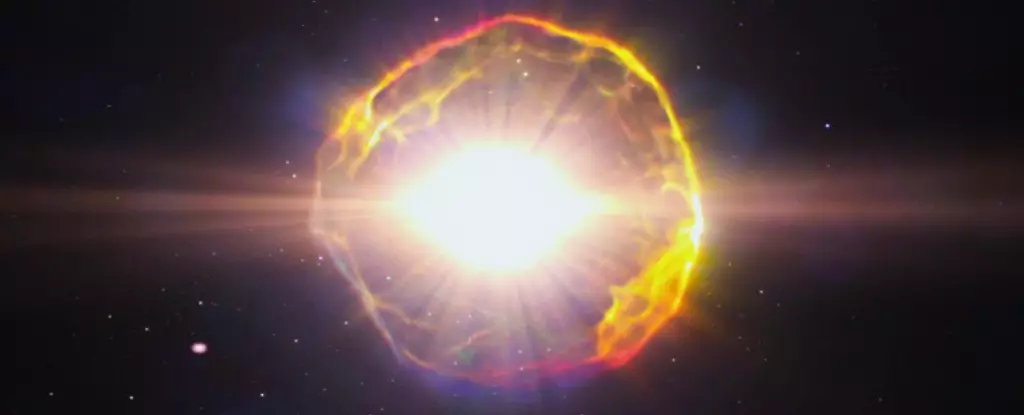Supernovae represent the spectacular deaths of massive stars, erupting in an explosion that can outshine entire galaxies. These phenomena are not just fascinating cosmic events but, as recent research suggests, they may have played a crucial role in shaping Earth’s biological history. A compelling study spearheaded by astrophysicist Alexis Quintana at the University of Alicante positions supernovae as potential triggers for at least two of Earth’s catastrophic mass extinction events: the Late Ordovician and Late Devonian extinctions. This insight challenges established narratives about these events, opening avenues for understanding how deeply interwoven cosmic phenomena are with life on our planet.
The brilliance of a supernova stems from the immense gravitational collapse of a massive star once it exhausts its nuclear fuel. Coupled with the unrelenting cosmic radiation emitted during such explosions, they serve as catastrophic reminders of the power the universe holds. The repercussions of a nearby supernova could be devastating, wiping out ecosystems and rendering the planet inhospitable. This transformative idea underscores not only the fragility of life but also the myriad external forces that can dictate its fate.
A Historical Perspective on Mass Extinctions
Throughout Earth’s history, there have been five major mass extinctions, events that forever altered the course of evolution. The Late Ordovician and Late Devonian extinctions, occurring approximately 445 million and 372 million years ago, respectively, are characterized by dramatic reductions in biodiversity. Understanding the causes of these cataclysmic events remains a topic of vigorous debate among paleontologists, ecologists, and now astrophysicists. The correlation between these extinctions and the depletion of the ozone layer from potential supernova explosions merits serious consideration, revealing an interconnectedness between the cosmos and terrestrial life.
Past theories surrounding these extinctions primarily focused on volcanism, climate change, and asteroid impacts. The potential inclusion of supernovae expands this framework, suggesting that cosmic events can have terrestrial consequences. The common thread connecting these extinction events — a significant drop in Earth’s ozone layer, believed to have shielded life from harmful ultraviolet radiation — indicates that we must broaden our inquiry into life’s vulnerabilities.
Deciphering the Data
The research led by Quintana entailed a meticulous survey of OB-type stars within a kiloparsec of Earth. These high-mass stars are known for their short lifespans and high supernovae rates. Through analyzing data on these massive stellar bodies, Quintana’s team calculated the supernova frequency in our vicinity to be 2.5 per billion years. This figure precisely aligns with the timing of the aforementioned extinction events, hinting at a plausible shift in our understanding of Earth’s ecological history.
The thoroughness of this astronomical survey reinforces the importance of interdisciplinary scientific contemplation. As the boundaries between astrophysics and Earth sciences blur, it emerges that extinction events may not solely be attributed to terrestrial phenomena but could have larger cosmic contexts. Furthermore, the enlightened view presented regarding the potential for catastrophe changes the narrative surrounding Earth’s historical limitations and resilience.
The Future of Earth’s Survival: Cosmic and Terrestrial Threats
Astrophysical threats like nearby supernovae might spark existential dread; however, understanding their actual risk provides a more nuanced perspective. Currently, astronomical observations reveal a lack of imminent supernova threats within a relatively close radius. The closest candidates, such as Antares and Betelgeuse, are hundreds of light-years away and pose no immediate risk. Yet, as the study indicates, history tells us that not all extinction events are cosmic in origin. Rogue asteroids, terrestrial volcanoes, and climatic shifts continue to loom as significant threats.
Rather than succumbing to anxiety over distant cosmic realities, our focus should shift toward understanding and preparing for the challenges on our doorstep. This cosmic caution lends credence to the adage that while we are but specks in the universe, the anomalies of the cosmos matter. The cycle of existence ensures that our planet remains susceptible to myriad forces, both cosmic and terrestrial, prompting constant adaptation and vigilance.
In realms where supernovae may serve as obscure cosmic bullet points, we must not overlook the immediate Earthly dynamics shaping our future. The research beckons an opportunity for enriched dialogue that fuses cosmology with Earth system science, fostering comprehensive insights about existence, survival, and vulnerability in the expansive tapestry of time. As humanity continues to seek control over its fate, recognizing the agency of cosmic phenomena in our narrative becomes crucial in shaping a resilient future.

